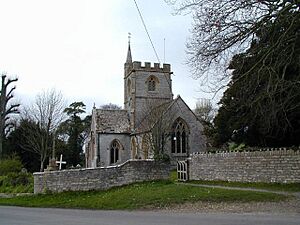Church of St Mary, Charlton Mackrell facts for kids
Quick facts for kids Church of St Mary |
|
|---|---|
 |
|
| Location | Charlton Mackrell, Somerset, England |
| Built | 13th century |
|
Listed Building – Grade II*
|
|
| Official name: Church of St Mary | |
| Designated | 17 April 1959 |
| Reference no. | 1056728 |
| Lua error in Module:Location_map at line 420: attempt to index field 'wikibase' (a nil value). | |
The Church of St Mary is an old church located in Charlton Mackrell, a village in Somerset, England. It was built a very long time ago, in the 13th century. Today, it is recognized as a special historic building, known as a Grade II* listed building. This means it's an important part of England's history and needs to be protected.
Contents
History
How Old Is It?
The Church of St Mary was first built in the 1200s, which is the 13th century. Over the years, it has been carefully repaired and updated. Major restoration work happened in the 1790s and again in the 1840s.
Changes Over Time
Around 1330, the beautiful stone patterns in the windows of the transept were added. A transept is like the "arms" of a cross-shaped church. However, the original glass that was in these windows is no longer there.
During the 1840s restoration, some big changes were made. A "singing gallery," which was a raised area where people might sing, was removed. Many parts of the church were rebuilt. A new room called a vestry was also added on the north side of the building.
The church is part of a group of churches called a benefice. This group includes churches in Somerton, the Charltons, and Kingsdon. They all belong to the Diocese of Bath and Wells.
Architecture
What It Looks Like Outside
The Church of St Mary is built from a type of local stone called hamstone. Its roofs are made of slate. The chancel, which is the part of the church near the altar, has strong corner buttresses. These are supports that help hold up the walls. The south transept also has these buttresses.
The church tower has interesting stone carvings on the outside called gargoyles. These often look like strange creatures and are designed to spout water away from the building. Inside the tower, there are six bells.
What It Looks Like Inside
When you go inside the church, you can see a circular font that dates back to the 13th century. This is where baptisms take place. Most of the other decorations and the colorful stained glass windows you see today were added in the 19th century. This was part of a big period of church renovation known as the Victorian restoration.

